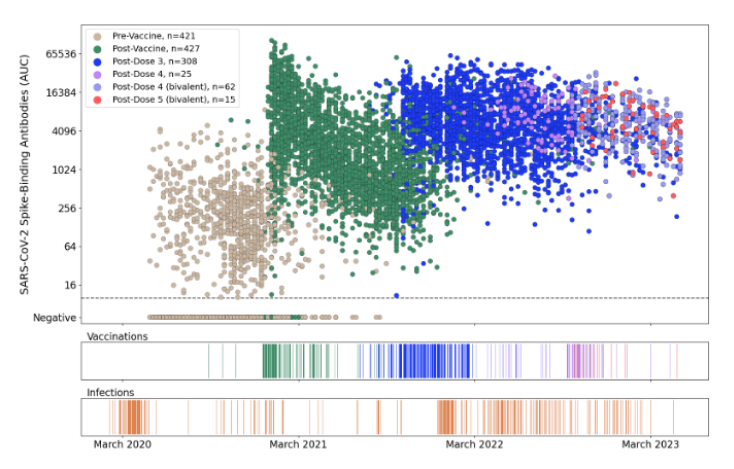1) Our preprint describing 3 years of our PARIS study is live. There are a few interesting observations I wanted to highlight. This was the work of a large team but the lead is really @VivianaSimonLab medrxiv.org/content/10.110…
2) First, here is an overview of the spike titers of all the study time points. We had 501 individuals in the study and measure their anti-spike binding antibodies on a regular basis. 

3) The first take home message is: Antibody decay after mRNA vaccination is biphasic. First a steep drop, then a stabilization phase. The graph here shows titers after the primary immunization series. Blue is previously naive individuals, orange is hybrid immune. 

4) While serum titers post vaccination are higher in the hybrid group post the primary series, the booster dose seems to act as equalizer. Also, decay seems slower here. 

5) We modeled the decay. Orange: hybrid immune after primary series; blue naive after primary series; purple: both post-boost. 

6) The biphasic decay is textbook immunology. Plasmablast made the peak titer after vaccination, but they die quickly. The antibody sticks around longer because IgG has a half-life of about 4 weeks. Antibodies in the stabilization phase....
7)...are are made by long-lived plasma cells which in the meantime migrated to the bone marrow. They will likely keep going for a very long time, potentially life long. mRNA vaccination induced long lived immune responses if spike binding titers are considered.
8) Of note, long lived immune responses does not necessarily mean long lived protection from symptomatic disease. If the virus changes and escapes the neutralizing antibody response, we get breakthroughs.
9) And that is what we saw. Before Omicron emerged, we had very few breakthroughs in the cohort, and all in naive and then vaccinated individuals, none in the hybrid immune group. 

10) But when Omicron hit, we got breakthroughs in both groups. However, the hybrid immune group was still better protected. Maybe the difference is mucosal immunity? () biorxiv.org/content/10.110…


11) This was protection from symptomatic disease. However, it seems even mismatched immunity protects from severe disease and mortality, as long as binding antibodies are maintained. This was reported recently from Sweden. thelancet.com/journals/lanep…
12) So, having long term immune responses is a good thing, even if these antibodies don't neutralize the latest variant.
13) What do breakthrough infections do to antibody titers. We found that an initial breakthrough acts like a booster dose in people who have never been infected. A breakthrough in a hybrid immune person however, does not induce strong serum antibody titers. Likely... 

14) ...because there may be less virus replication and therefore less antigen exposure. However, these individuals still respond with a mucosal sIgA response as shown here: biorxiv.org/content/10.110…
16) In summary, we don't think mRNA vaccines induce short lived immunity. Read the preprint if you are interested: medrxiv.org/content/10.110…
17) PS: Since people find the last tweet confusing I'll rephrase. We find that mRNA vaccines induce long lived immunity.
• • •
Missing some Tweet in this thread? You can try to
force a refresh

 Read on Twitter
Read on Twitter








